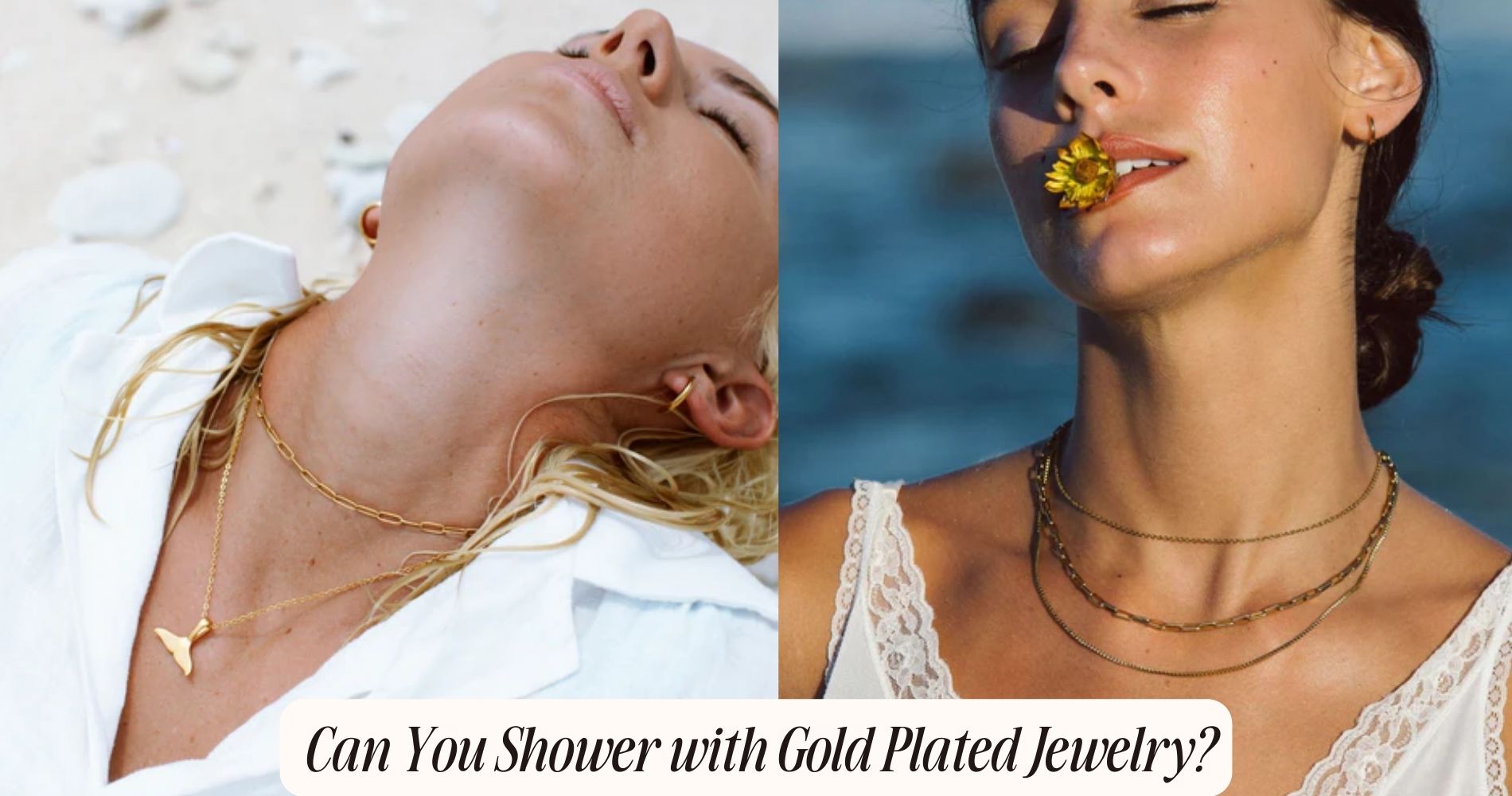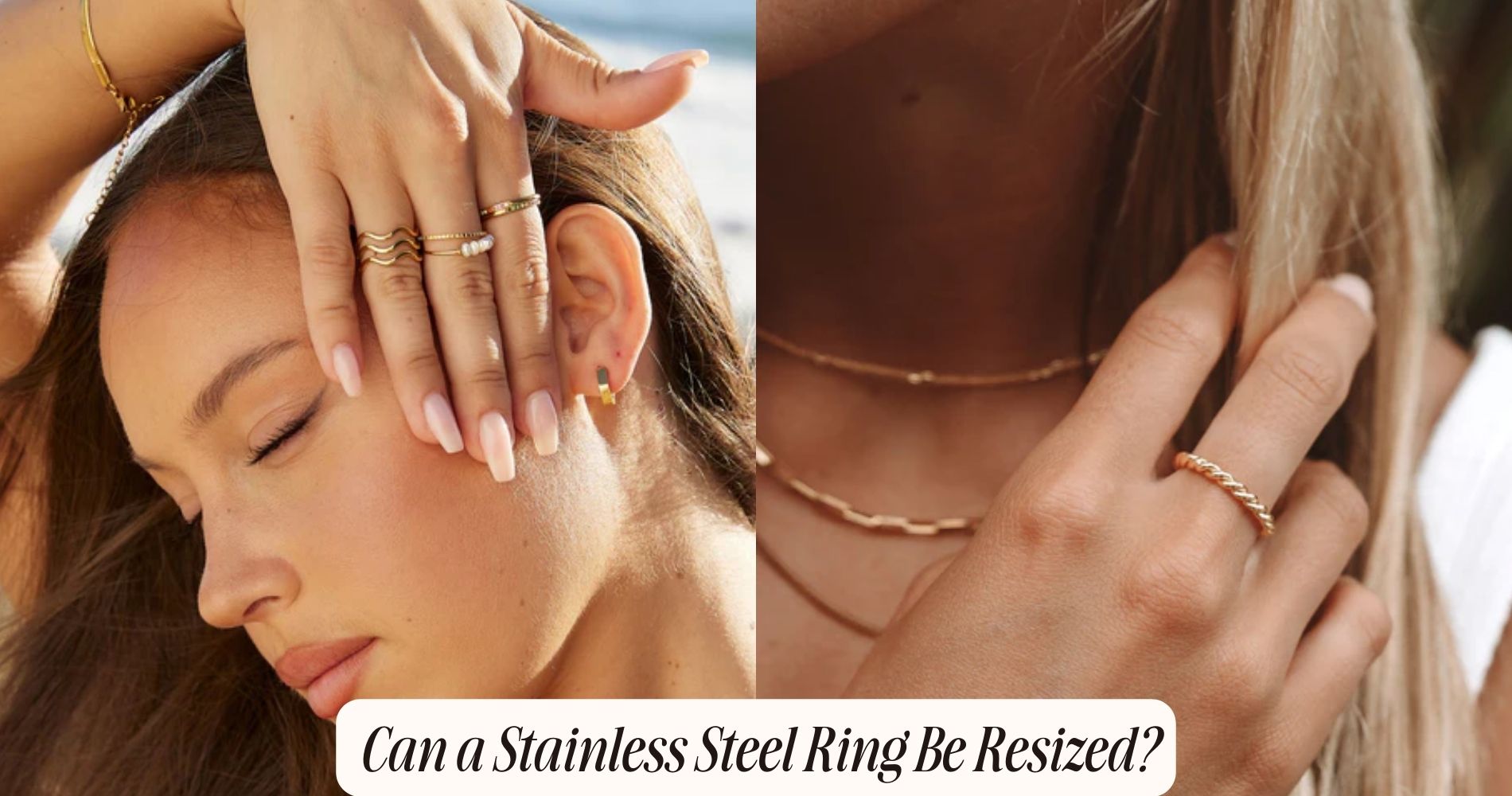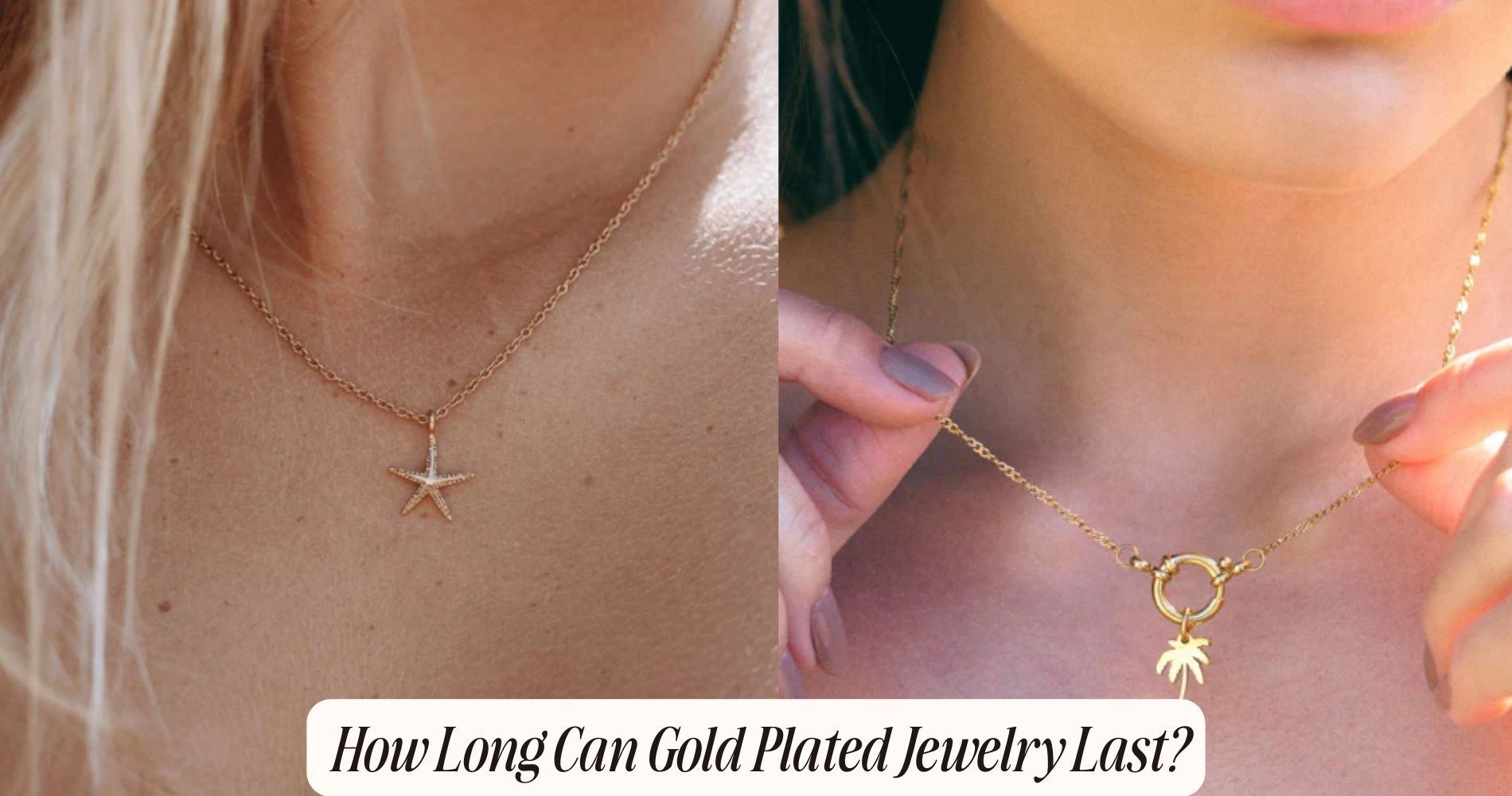
Can You Shower with Gold Plated Jewelry?
What Is Gold-Plated Jewelry?
Gold-plated jewelry consists of a base metal, such as brass or copper, coated with a thin layer of real gold through an electroplating process. This type of jewelry is popular for its ability to mimic the appearance of solid gold without the hefty price tag. When you explore various jewelry types, you'll notice that gold-plated items can range from necklaces and bracelets to earrings and rings. Each piece reflects the latest fashion trends, making them versatile additions to any wardrobe.
You'll find that gold-plated jewelry offers a stylish and affordable way to keep up with ever-changing fashion trends. Whether it's a delicate gold-plated chain or a statement bangle, these pieces allow you to experiment with different looks without a long-term commitment. The thin layer of gold applied in the electroplating process ensures that the jewelry shines just like solid gold, capturing the essence of elegance and sophistication.
However, it's essential to understand that gold-plated jewelry requires special care to maintain its luster. Because the gold layer is thin, it's more susceptible to wear and tear compared to solid gold. By understanding these nuances, you can confidently select and care for your gold-plated pieces.
How Gold Plating Works
You might be curious about how gold plating is done, and it involves a process called electroplating.
This technique uses an electric current to bind a thin layer of gold to a base metal.
The thickness of the gold layer greatly influences the jewelry's durability and its resistance to wear and tear.
Electroplating Process Basics
Understanding how gold plating works involves delving into the electroplating process, where a thin layer of gold is applied to a base metal using an electric current. First, let's consider the metal types commonly used for the base. These typically include copper, silver, or nickel, each chosen for their conductivity and affinity for gold.
Before the actual plating begins, the base metal must undergo meticulous surface preparation. This involves cleaning the metal to remove any dirt, oil, or oxidation, guaranteeing a smooth, receptive surface for the gold. This step often includes ultrasonic cleaning, acid baths, and abrasive polishing to achieve the desired purity and roughness.
Once the base metal is prepped, it's submerged into a solution called the electrolyte, containing gold ions. An electric current is then applied, causing the gold ions to move toward and adhere to the base metal. This results in a uniformly thin, lustrous layer of gold forming on the surface.
The precision of the process ensures that the gold layer is firmly bonded to the base, providing an attractive finish often indistinguishable from solid gold.
Thickness and Durability
Once the gold layer is applied, measuring its thickness becomes paramount to determine the jewelry's longevity and resistance to wear. The durability of gold plated jewelry directly correlates with the layer thickness. A thicker layer of gold enhances the piece's ability to withstand daily wear and exposure to elements, including water during showers.
Gold plating typically ranges from 0.5 microns (very thin) to 2.5 microns (thicker and more durable). For context, a micron is one-millionth of a meter. Jewelry with a gold layer thickness above 1 micron generally offers better durability, making it more resistant to scratches and fading compared to pieces with thinner layers.
In a durability comparison, thicker gold plating notably outperforms thinner coatings. For instance, a piece with a 2.5-micron gold layer will last much longer and maintain its luster better than one with just a 0.5-micron layer. However, even the thickest gold plating won't match the durability of solid gold jewelry.
When deciding whether to shower with your gold plated jewelry, consider the layer thickness. Thicker plating can better endure occasional exposure to water, but frequent exposure will inevitably wear down the gold layer over time.
Impact of Water on Gold-Plated Jewelry
Ever wondered how exposure to water can affect your gold-plated jewelry? When gold-plated items come into contact with water, several factors can compromise their appearance and longevity. Chlorine exposure, for instance, can be particularly damaging. Found in tap water and swimming pools, chlorine can erode the thin layer of gold plating, causing it to wear away faster. Over time, this leaves the base metal exposed, leading to tarnishing and discoloration.
Additionally, water often contains various minerals that can leave deposits on your jewelry. These mineral deposits can accumulate on the surface, making the jewelry look dull and lifeless. They can also be difficult to remove, requiring specialized cleaning methods that might further stress the delicate gold plating.
Moreover, constant exposure to water can accelerate the breakdown of the adhesive layer that binds the gold plating to the base metal. This means your jewelry is more likely to chip, peel, or flake, revealing the less attractive metal underneath.
To preserve the luster and quality of your gold-plated jewelry, it's best to avoid prolonged water exposure whenever possible. Your pieces will thank you for it!
Soap and Its Effects
Not only does water affect gold-plated jewelry, but the soap you use during showers can also greatly impact its condition. Common soap ingredients, such as sulfates, can be particularly harsh on gold plating. These ingredients strip away the thin layer of gold, leading to dullness and even causing the base metal to show through.
Additionally, other chemicals found in soap can accelerate tarnishing, jeopardizing the jewelry's appearance and longevity.
Lather quality plays a critical role too. Soaps that create a thick, rich lather often contain more surfactants, which can be abrasive to the delicate gold plating. The more lather a soap produces, the more it tends to cling to surfaces, making it harder to rinse off completely.
This residue can build up over time, causing a film that dulls the jewelry's shine and contributes to tarnish.
To prolong the life of your gold-plated jewelry, opt for mild, natural soaps with minimal additives. Ingredients like olive oil, shea butter, and other gentle cleansers are less likely to harm the plating.
Always make sure thorough rinsing to prevent any soap residue from lingering on your jewelry.
Steam and Humidity Concerns
Steam and humidity in the shower can accelerate the degradation of your gold-plated jewelry, causing it to lose its luster and develop tarnish more quickly. When you shower, the high levels of moisture buildup create an environment that can penetrate the thin gold layer, leading to the base metal underneath becoming exposed. This exposure not only dulls the appearance of your jewelry but can also result in skin irritation.
Humidity intensifies the presence of moisture on your skin and within the microscopic crevices of your jewelry. This constant dampness can make the gold plating wear off faster, especially if it's thin. As the gold layer weakens, the base metal can react with your skin, potentially causing rashes or other forms of irritation.
Additionally, the steam from a hot shower opens up your skin's pores, making it more susceptible to irritations from metals that aren't as hypoallergenic as gold. For people with sensitive skin, this can be a significant concern.
Therefore, to preserve the beauty and longevity of your gold-plated jewelry and avoid any discomfort, it's best to keep it away from the steamy, humid conditions of your shower.
Chemical Reactions and Tarnishing
Chemical reactions between your gold-plated jewelry and substances like soap, shampoo, and body wash can accelerate tarnishing and diminish the jewelry's appearance. Gold plating is a thin layer of gold applied over a base metal, often an alloy like brass or copper. The alloy composition and the chemical properties of the base metal play a significant role in how your jewelry reacts when exposed to various chemicals in personal care products.
When you shower, the chemicals in your soap and shampoo can react with the base metals beneath the gold plating. These chemical reactions can cause the base metals to oxidize, leading to tarnishing. The gold layer itself may not tarnish, but because it's so thin, any damage to it can expose the underlying metal. This exposure accelerates the tarnishing process, making your jewelry look dull and worn over time.
Moreover, the pH levels of your body wash can also affect the jewelry's appearance. Alkaline or acidic products can weaken the gold plating, causing it to wear off more quickly. Understanding the chemical properties of both your jewelry and the products you use is essential for maintaining its shine and longevity.
Protective Measures to Consider
To keep your gold-plated jewelry looking its best, you should implement a few important protective measures. First, consider using protective coatings designed specifically for jewelry. These coatings act as a barrier, shielding your pieces from moisture and other elements that can lead to tarnishing. You can find sprays or liquids that are easy to apply and create an invisible layer of protection. Just make sure to follow the application instructions closely for the best results.
Another vital step is to adopt proper drying methods. After exposure to water, gently pat your gold-plated jewelry dry with a soft, lint-free cloth. Avoid rubbing, as this can wear away the delicate gold layer. You might also consider using a hairdryer on a cool setting to make certain all moisture is removed from crevices and intricate designs. By thoroughly drying your jewelry, you prevent water spots and reduce the risk of tarnish.
Additionally, store your gold-plated items in a dry, cool place. Consider using anti-tarnish strips in your jewelry box to absorb any lingering moisture. These measures will go a long way in preserving the shine and longevity of your treasured pieces.
Best Practices for Jewelry Care
To keep your gold plated jewelry looking its best, you should establish a gentle cleaning routine, store it properly, and be mindful of factors that could cause damage.
Use a soft cloth for regular cleaning and keep each piece in a separate pouch or compartment.
Avoid exposing your jewelry to harsh chemicals, excessive moisture, and physical abrasion to maintain its shine and longevity.
Cleaning Routine Tips
Maintaining the luster and longevity of your gold-plated jewelry requires a diligent cleaning routine that avoids abrasive materials and harsh chemicals. Start by considering your material choices. Opt for a mild soap, free from sulfates and fragrances, to clean your pieces. This guarantees the gold plating remains intact without being stripped away. Additionally, use a soft, lint-free cloth to gently wipe the jewelry. Avoid paper towels or tissues, as they can be abrasive and cause scratches.
Next, assess the wear frequency of each piece. Jewelry worn daily accumulates more dirt and oils than pieces worn occasionally. For daily wear items, a bi-weekly cleaning is advisable. If you wear certain items less frequently, a monthly cleaning schedule should suffice.
To clean, fill a bowl with lukewarm water and add a few drops of the mild soap. Soak the jewelry for a few minutes, then use a soft brush (like a toothbrush with soft bristles) to gently clean intricate areas. Rinse thoroughly with clean water and pat dry with the lint-free cloth. It's crucial to make sure the jewelry is completely dry before wearing it again to prevent any moisture damage.
Storage and Protection
For maximum storage and protection of your gold-plated jewelry, make sure each piece is kept in a soft-lined box or a fabric pouch to prevent scratches and tarnish.
Using individual storage containers is vital to avoid pieces rubbing against each other, which can wear away the gold plating. Invest in boxes with separate compartments or soft pouches to keep each item isolated and secured.
Humidity control is another essential factor. Excessive moisture can accelerate tarnishing, so store your jewelry in a cool, dry place. Consider using silica gel packets within your storage containers to absorb any excess humidity. You can also use anti-tarnish strips, which are designed to neutralize tarnish-causing agents in the air.
Avoid storing your gold-plated jewelry in bathrooms or other high-humidity areas. Instead, opt for a bedroom drawer or a dedicated jewelry box with built-in humidity control features.
Always make sure your jewelry is completely dry before storing it to prevent any moisture from being trapped inside the storage container. By following these best practices, you'll extend the lifespan and maintain the shine of your cherished gold-plated pieces.
Avoiding Damage Factors
Regularly cleaning your gold-plated jewelry with a soft cloth will help maintain its luster and prevent buildup of oils and dirt. To safeguard your pieces from damage, always make sure to remove them before engaging in activities like swimming, exercising, or showering. Water, especially chlorinated or saltwater, can accelerate the tarnishing process and weaken the gold layer.
When it comes to storage, make certain your gold-plated jewelry is kept in a dry, cool place, away from direct sunlight. Use individual pouches or compartments in a jewelry box to prevent scratches and contact with other pieces. This careful storage aligns with current jewelry trends that emphasize the longevity and sustainability of your collection.
Avoid exposing your gold-plated items to harsh chemicals found in cleaning products, perfumes, and lotions. These substances can corrode the gold layer and dull its shine. If you're looking for gold alternatives, consider pieces made from stainless steel or titanium, which are more resistant to wear and tear.
Alternatives to Showering With Jewelry
Instead of wearing your gold-plated jewelry in the shower, why not consider keeping it safe and opting for alternative accessories designed for wet environments? Jewelry alternatives such as silicone rings or bracelets are excellent choices for those who want to maintain style without risking damage. These non-metal options are waterproof, durable, and come in various colors and designs, allowing you to express your personality even in the shower.
Silicone jewelry isn't your only option. You can also explore accessories made from materials like rubber, plastic, or even high-quality resin. These materials are specifically designed to withstand moisture and won't tarnish or corrode over time.
Additionally, some waterproof fabric bracelets offer a unique, stylish touch while being entirely shower-friendly.
For a more natural approach, consider wooden or hemp jewelry. These pieces are often treated to be water-resistant and can add a rustic, earthy vibe to your look. Remember, the key is to choose items that can handle consistent exposure to water without losing their charm.
Long-Term Maintenance Tips
To keep your gold plated jewelry looking its best, you need to prevent tarnish buildup and establish a regular cleaning routine.
Store your pieces in a dry, airtight container when you're not wearing them, and gently clean them with a soft cloth and mild soap every few weeks.
Prevent Tarnish Buildup
A soft, lint-free cloth is your best ally in preventing tarnish buildup on your gold-plated jewelry. Gently wipe your pieces after each wear to remove body oils, sweat, and any environmental pollutants that can contribute to tarnishing. Avoid using abrasive materials or harsh cleaning agents, as these can strip the delicate gold plating and accelerate tarnish.
Incorporating tarnish inhibitors into your jewelry storage routine can be highly effective. Anti-tarnish strips or pouches, which are readily available, can absorb moisture and other elements that promote tarnish. Place these inhibitors in your jewelry box to create a protective environment for your pieces.
Store your gold-plated jewelry in a cool, dry place, ideally in individual soft pouches or cloth-lined compartments. This prevents scratches and minimizes exposure to air, which can lead to oxidation.
Avoid exposing your jewelry to chemicals found in lotions, perfumes, and hair products. These substances can hasten the tarnishing process. Instead, put on your gold-plated jewelry last when dressing and remove it first when undressing.
Regular Cleaning Routine
Maintaining a regular cleaning routine is crucial to preserving the luster and longevity of your gold-plated jewelry. To keep it looking its best, you should clean your pieces regularly, ideally once a month. This cleaning frequency guarantees that dirt, oils, and other residues don't accumulate and dull the shine of your jewelry.
When selecting cleaning products, opt for mild, non-abrasive solutions. A mixture of warm water and a few drops of gentle dish soap usually works well. Avoid harsh chemicals or abrasive cleaners, as these can strip the gold layer. Use a soft cloth or a cotton ball to gently rub the surface of your jewelry.
If you encounter stubborn spots, a soft-bristled toothbrush can help, but be very gentle to avoid scratching. After cleaning, rinse your jewelry thoroughly with lukewarm water and pat it dry with a clean, soft cloth. Make sure it's completely dry before storing it to prevent any moisture-related tarnish.
Consistent care and the right cleaning products will keep your gold-plated jewelry radiant and extend its lifespan, allowing you to enjoy its beauty for years to come.
Conclusion
To keep your gold-plated jewelry looking its best, it's important to avoid showering with it. Water, soap, and steam can all degrade the plating over time, leading to tarnish and wear.
Instead, remove your jewelry before showering and store it in a dry place. By taking these precautions, you'll extend the life and luster of your pieces, ensuring they remain beautiful and vibrant for years to come.
Proper care truly makes a difference.


























Leave a comment
This site is protected by hCaptcha and the hCaptcha Privacy Policy and Terms of Service apply.